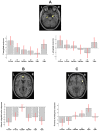The brain functional networks associated to human and animal suffering differ among omnivores, vegetarians and vegans
- PMID: 20520767
- PMCID: PMC2877098
- DOI: 10.1371/journal.pone.0010847
The brain functional networks associated to human and animal suffering differ among omnivores, vegetarians and vegans
Abstract
Empathy and affective appraisals for conspecifics are among the hallmarks of social interaction. Using functional MRI, we hypothesized that vegetarians and vegans, who made their feeding choice for ethical reasons, might show brain responses to conditions of suffering involving humans or animals different from omnivores. We recruited 20 omnivore subjects, 19 vegetarians, and 21 vegans. The groups were matched for sex and age. Brain activation was investigated using fMRI and an event-related design during observation of negative affective pictures of human beings and animals (showing mutilations, murdered people, human/animal threat, tortures, wounds, etc.). Participants saw negative-valence scenes related to humans and animals, alternating with natural landscapes. During human negative valence scenes, compared with omnivores, vegetarians and vegans had an increased recruitment of the anterior cingulate cortex (ACC) and inferior frontal gyrus (IFG). More critically, during animal negative valence scenes, they had decreased amygdala activation and increased activation of the lingual gyri, the left cuneus, the posterior cingulate cortex and several areas mainly located in the frontal lobes, including the ACC, the IFG and the middle frontal gyrus. Nonetheless, also substantial differences between vegetarians and vegans have been found responding to negative scenes. Vegetarians showed a selective recruitment of the right inferior parietal lobule during human negative scenes, and a prevailing activation of the ACC during animal negative scenes. Conversely, during animal negative scenes an increased activation of the inferior prefrontal cortex was observed in vegans. These results suggest that empathy toward non conspecifics has different neural representation among individuals with different feeding habits, perhaps reflecting different motivational factors and beliefs.
Conflict of interest statement
Figures




Similar articles
-
The "vegetarian brain": chatting with monkeys and pigs?Brain Struct Funct. 2013 Sep;218(5):1211-27. doi: 10.1007/s00429-012-0455-9. Epub 2012 Sep 29. Brain Struct Funct. 2013. PMID: 23052545
-
Spontaneous verbal descriptions of vegans, non-vegan vegetarians, and omnivores and relationships between these descriptions and perceivers' diets.PLoS One. 2023 Dec 7;18(12):e0293899. doi: 10.1371/journal.pone.0293899. eCollection 2023. PLoS One. 2023. PMID: 38060469 Free PMC article.
-
Adherence to a Mediterranean diet by vegetarians and vegans as compared to omnivores.Int J Food Sci Nutr. 2020 May;71(3):378-387. doi: 10.1080/09637486.2019.1663797. Epub 2019 Sep 26. Int J Food Sci Nutr. 2020. PMID: 31558068
-
Differences Between Omnivores and Vegetarians in Personality Profiles, Values, and Empathy: A Systematic Review.Front Psychol. 2021 Oct 7;12:579700. doi: 10.3389/fpsyg.2021.579700. eCollection 2021. Front Psychol. 2021. PMID: 34690847 Free PMC article.
-
Meta-analytic evidence for common and distinct neural networks associated with directly experienced pain and empathy for pain.Neuroimage. 2011 Feb 1;54(3):2492-502. doi: 10.1016/j.neuroimage.2010.10.014. Epub 2010 Oct 12. Neuroimage. 2011. PMID: 20946964 Review.
Cited by
-
The Complexity of the Human-Animal Bond: Empathy, Attachment and Anthropomorphism in Human-Animal Relationships and Animal Hoarding.Animals (Basel). 2022 Oct 19;12(20):2835. doi: 10.3390/ani12202835. Animals (Basel). 2022. PMID: 36290219 Free PMC article. Review.
-
Personality, dietary identity, mental and sleep health in vegans and vegetarians: A preliminary cross-sectional study.Health Sci Rep. 2023 Aug 22;6(8):e1525. doi: 10.1002/hsr2.1525. eCollection 2023 Aug. Health Sci Rep. 2023. PMID: 37621383 Free PMC article.
-
Are They Really Trying to Save Their Buddy? The Anthropomorphism of Animal Epimeletic Behaviours.Animals (Basel). 2020 Dec 7;10(12):2323. doi: 10.3390/ani10122323. Animals (Basel). 2020. PMID: 33297457 Free PMC article.
-
What Does Our Personality Say About Our Dietary Choices? Insights on the Associations Between Dietary Habits, Primary Emotional Systems and the Dark Triad of Personality.Front Psychol. 2019 Nov 22;10:2591. doi: 10.3389/fpsyg.2019.02591. eCollection 2019. Front Psychol. 2019. PMID: 31824377 Free PMC article.
-
Replication dataset: the effect of compassion, biological sex, and gender identity threat on jerky choice.Data Brief. 2021 Nov 19;39:107595. doi: 10.1016/j.dib.2021.107595. eCollection 2021 Dec. Data Brief. 2021. PMID: 34869808 Free PMC article.
References
-
- Decety J, Chaminade T. When the self represents the other: a new cognitive neuroscience view on psychological identification. Conscious Cogn. 2003;12:577–596. - PubMed
-
- Decety J, Jackson PL. The functional architecture of human empathy. Behav Cogn Neurosci Rev. 2004;3:71–100. - PubMed
-
- Hein G, Singer T. I feel how you feel but not always: the empathic brain and its modulation. Curr Opin Neurobiol. 2008;18:153–158. - PubMed
-
- Singer T, Lamm C. The social neuroscience of empathy. Ann N Y Acad Sci. 2009;1156:81–96. - PubMed
MeSH terms
LinkOut - more resources
Full Text Sources
Medical

